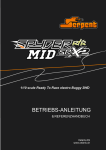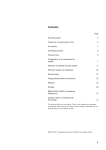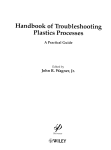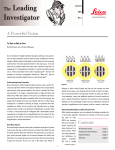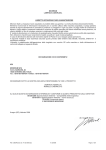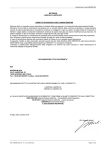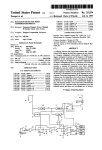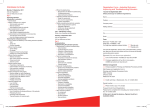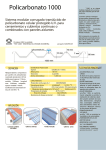Download 3 Systematic Troubleshooting
Transcript
3 Systematic Troubleshooting 3.1 Upsets versus Development Problems This chapter will primarily focus on upsets, problems that occur in an existing extrusion line for an unknown reason. If the extrusion line had been running fine for a considerable period of time, then it is clear that there must be a solution to the problem. Thus, the objective of troubleshooting is to find the cause of the upset and eliminate it. On the other hand, there may be no solution to a development problem. Solving a development problem involves establishing a condition that has not been achieved before. If it is physically impossible to establish the desired condition, then, clearly, there is no solution to the problem. A functional analysis of the process should make it possible to determine the bounds of the conditions that can be realized in practice. 3.2 Machine-Related Problems In machine-related problems, mechanical changes in the extruder cause a change in extrusion behavior. These changes can affect the drive system, the heating and cooling system, the feed system, the forming system, or the actual geometry of the screw and the barrel. The main components of the drive are the motor, the reducer, and the thrustbearing assembly. Drive problems manifest themselves as variations in rotational speed and/or the inability to generate the required torque. Problems in the reducer and thrust bearings are often associated with clear audible signals of mechanical failure. If the problem is suspected to be the drive, make sure that the load conditions do not exceed the drive capacity. 3.2.1 The Drive System Older motor drive systems generally consist of a direct current (DC) brush motor, a power conversion unit (PCU), and operator controls. A frequent problem with the motor itself is worn brushes; these should be replaced at regular intervals as recommended by the manufacturer. The manufacturer’s recommendations should also be followed in troubleshooting an extruder drive. A typical troubleshooting guide for a DC motor is shown in Table 3.1. 22 Systematic Troubleshooting Table 3.1 Troubleshooting Guide for DC Motor Problem Possible cause Action Motor will not start Low armature voltage Make sure motor is connected to proper voltage Check for resistance in the shunt field circuit Check for open circuit Weak field Open circuit in armature or field Short circuit in armature or field Motor runs too slow Low armature voltage Overload Brushes ahead of neutral Motor runs too fast High armature voltage Weak field Brushes behind neutral Brushes sparking Brushes worn Brushes not seated properly Incorrect brush pressure Brushes stuck in holder Commutator dirty Commutator rough or eccentric Brushes off neutral Short circuit in commutator Overload Excessive vibration Check for short circuit Check for resistance in armature circuit Reduce load or use larger motor Determine proper neutral position for brush location Reduce armature voltage Check for resistance in shunt field circuit Determine proper neutral position for brush location Replace Reseat brushes Measure brush pressure and correct Free brushes, make sure brushes are of proper size Clear commutator Resurface commutator Determine proper neutral position for brush location Check for shorted commutator, and check for metallic particles between commutator segment Reduce load or use larger motor Check driven machine for balance Brush chatter Incorrect brush pressure High mica Incorrect brush size Measure and correct Undercut mica Replace with proper size Bearings hot Belt too tight Misaligned Bent shaft Bearing damage Reduce belt tension Check alignment and correct Straighten shaft Inspect and replace 4 Case Studies In this chapter several actual case studies will be discussed. They cover a variety of problems, each with a different solution. 4.1 Film Coextrusion—Degradation in the Middle Layer 4.1.1 Description of the Problem This case involved a three-layer coextruded film with an A–B–A configuration. The A–layers are made of a random copolymer PP (natural), each 3-micron thick, and the B–layer is a 9-micron homopolymer PP (natural). The middle layer is extruded on a 200-mm single-screw extruder, and outer layers are extruded on a 120-mm single-screw extruder. The polymer streams flow into a feed block and from there to a cast film line. The extrusion line is fully instrumented. The film is biaxially oriented subsequent to extrusion. The problem in this film was an appearance problem caused by gels. The defects looked like fisheyes. The problem with biaxial orientation is that defects in the extruded film become magnified during the orientation process, which in some cases can lead to film breakage. The first objective was to determine the location of the introduction of the defect. To accomplish this, the region around the gel was examined using an optical microscope. 4.1.2 Analysis of the Problem The film was cut through the gel to allow examination of the film cross section. Then the sample was embedded in epoxy resin and polished after curing of the epoxy. A micrograph, shown in Fig. 4.1, was taken at 200 X magnification illuminated with transmitted and polarized light. The microscope was a Leica optical microscope, Laborlux 12 Pol S, equipped with polishing and microtome capability. The illumination could be transmitted, reflected, and polarized. The micrograph shows that the gel was located in the middle layer. The discoloration of the material in the middle layer indicated degradation. At this point the plant was visited and the operation of the extruders was checked, particularly the 200-mm extruder with L/D = 24. The extruder operating conditions are shown in Table 4.1. 108 Case Studies Figure 4.1 Optical micrograph of three-layer film Table 4.1 Operating Conditions of 200-mm Extruder Screw rotation speed, rpm Extruder back pressure, bar Barrel temperature profile, °C Temperature of polymer granules, °C Melt temperature, °C Output, kg/h 255 65 190 (= feed zone), 200, 210, 220, 230, 240, 250 (= screw tip) 25 240 1,900 The extrusion line had a melt temperature probe at the discharge end of the extruder barrel just before the screen pack. Thus, the melt temperature had been taken at only one location, and at that location the temperature was found to be 240 °C. However, the melt temperature at the die exit was determined to be higher, close to 280 °C. This temperature was measured using an infrared temperature probe (Raytek, model Raynger PM). Though it was not possible to measure the melt temperature in the individual layers, it could be assumed that the high overall melt temperature represented mostly the temperature of the middle layer since it was the thickest part of the structure. The screw design for the 200-mm extruder was also checked. The geometry is summarized in Table 4.2. The screw geometry reflected a typical screw design for the processing of polyolefins. The screw compression ratio of 2.7 was appropriate for polypropylene. 4.1.3 Solution The solution strategy was visualized based on the fishbone diagram in Fig. 4.2, customized to the problem. Following this diagram, the causes were checked one by one. 4.1 Film Coextrusion—Degradation in the Middle Layer Table 4.2 Summary of Geometry of Existing Screw Diameter, mm Total length, L/D Feed zone: Channel depth, mm L/D Compression zone: L/D Metering zone: Channel depth, mm L/D Figure 4.2 Fishbone diagram of degradation problem 200 24 28.5 9 6 10.5 9 109 110 Case Studies Table 4.3 Screw Geometry of New Screw Feed zone: Channel depth, mm L/D Compression zone: L/D Metering zone: Channel depth, mm L/D Mixing zone: L/D 28.5 9 6 10.5 6 3 The recommended melt temperature for this process is around 260 °C. Therefore, the barrel temperatures of the 200-mm extruder were lowered to achieve a melt temperature at the die exit of 260 °C. It was possible in this case to lower the melt temperature by adjusting the barrel temperatures, but a melt temperature variation of about 10 °C across the width of the extrudate was observed. When the melt temperature was lowered to 260 °C the gel problem disappeared. The most effective method to reduce the melt temperature variation was to improve the mixing capability of the screw. A distributive mixing element was added to the metering zone. The final screw design is summarized in Table 4.3. Once a screw with the modified screw geometry was running, the melt temperature variation decreased significantly. 4.2 Film Coextrusion with Interfacial Problems 4.2.1 Description of the Problem This problem occurred in coextruded cast film. The film was a two-layer film in which one layer was ionomer and the other layer polyolefin. The total film thickness was 60 micron. The customer described the problem as a delamination in large sections of the film. 4.2.2 Analysis of the Problem In order to observe the different layers and the conditions at the interface clearly, a cross cut of the film was made, and the sample was embedded in epoxy resin and polished after the epoxy was cured. The magnification was 500 X, and reflected light was used because TiO2 was present in both polyolefin layers. A photomicrograph is shown in Fig. 4.3. The ionomer layer in the micrograph was about 20 microns thick, and the







